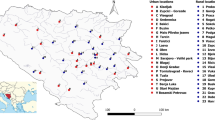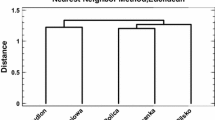Abstract
The study illustrates the response of epiphytic lichens to changing atmospheric conditions in Central Europe, where the emission of air pollutants has significantly decreased from 1990, in the area in and around Bratislava City. Variation in concentrations of seven metal elements (Cu, Cd, Cr, Mn, Ni, Pb and Zn) in the thalli of Evernia prunastri, Hypogymnia physodes and Parmelia sulcata is assessed. Samples of these species were exposed in lichen bags in 39 sites throughout the territory of the city (more than 300 km2) during the period December 2006–February 2007. The samples were analyzed by AAS for metal element contents prior to and after exposure. The decrease in air pollution (for all studied elements by more than 90%) corresponded to a decrease in the accumulation of elements in lichen thalli, e.g. the contents of Pb decreased by 69% and of Cd by 34% on average. The results show also variations in accumulation between with different lichen species. The background values of metal element contents in thalli of H. physodes growing in situ were measured in semi-natural sites in Slovakia. It is suggested that these can be used as a reference in large-scale monitoring studies in Central Europe. Analysis of compatible data from the current study, and the study performed at the end of 1990s shows a significant decrease of metal elements in the air pollution load.
Similar content being viewed by others
References
Bargagli, R., & Mikhailova, I. (2002). Accumulation of inorganic contaminants. In P. L. Nimis, C. Scheidegger, P. A. Wolseley (Eds.), Monitoring with lichens – monitoring lichens (pp. 65–84). New York: Kluwer.
Bari, A., Rosso, A., Minciardi, M. R., Troiani, F., & Piervittori, R. (2001). Analysis of heavy metals in atmospheric particulates in relation to their bioaccumulation in explanted Pseudevernia furfuracea thalli. Environmental Monitoring and Assessment, 69, 205–220.
Bennett, J. (2008). Discrimination of lichen genera and species using element concentrations. Lichenologist, 40, 135–151.
Bergamaschi, L., Rizzio, E., Giaveri, G., Loppi, S., & Gallorini, M. (2007). Comparison between the accumulation capacity of four lichen species transplanted to a urban site. Environmental Pollution, 148, 468–476.
Budka, D., Przybyłowicz, W. J., Mesjasz-Przybyłowicz, J., & Sawicka-Kapusta, K. (2002). Elemental distribution in lichens transplanted to polluted forest sites near Kraków (Poland). Nuclear Instruments and Methods in Physics Research Section B, 189, 499–505.
Cercasov, V., Pantelică, A., Sălăgean, M., Caniglia, G., & Scarlat, A. (2002). Comparative study of the suitability of three lichen species to trace-element air monitoring. Environmental Pollution, 119, 129–139.
Culicov, O. A., & Yurukova, L. (2006). Comparison of element accumulation of different moss- and lichen-bags, exposed in the city of Sofia (Bulgaria). Journal of Atmospheric Chemistry, 55, 1–12.
Dzubaj, A., Bačkor, M., Tomko, J., Peli, E., & Tuba, Z. (2008). Tolerance of the lichen Xanthoria parietina (L.) Th. Fr. to metal stress. Ecotoxicology and Environmental Safety, 70, 319–326.
Farkas, E., Lőkös, L., & Verseghy, K. (1985). Lichens as indicators of air pollution in the Budapest agglomeration I. Air pollution map based on floristic data and heavy metal concentration measurements. Acta Botanica Hungarica, 31, 45–68.
Frati, L., Brunialti, G., & Loppi, S. (2005). Problems related to lichen transplants to monitor trace element deposition in repeated surveys: A case study from Central Italy. Journal of Atmospheric Chemistry, 52, 221–230.
Fuga, A., Saiki, M., Marcelli, M. M., & Saldiva, P. H. N. (2008). Atmospheric pollutants monitoring by analysis of epiphythic lichens. Environmental Pollution, 151, 334–340.
Garty, J. (2002). Biomonitoring heavy metal pollution with lichens. In I. Kranner, R. P. Beckett, A. K. Varma (Eds.), Protocols in lichenology. Culturing, biochemistry, ecophysiology and use in biomonitoring (pp. 458–482). Heidelberg: Springer.
Giuffré de López Camelo, L., Ratto de Migues, S., & Marbán, L. (1997). Heavy metals input with phosphate fertilizers used in Argentina. Science of the Total Environment, 204, 245–250.
Godinho, R. M., Verburg, T. G., Freitas, M. C., & Wolterbeek, M. Th. (2009). Accumulation of trace elements in the peripheral and central parts of two species of epiphytic lichens transplanted to a polluted site in Portugal. Environmental Pollution, 157, 102–109.
Godinho, R. M., Wolterbeek, H. Th., Verburg, T., & Freitas, M. C. (2008). Bioaccumulation behaviour of transplants of the lichen Flavoparmelia caperata in relation to total deposition at a polluted location in Portugal. Environmental Pollution, 151, 318–325.
James, P. W. (1973). The effects of air pollutants other than hydrogen fluoride and sulphur dioxide on lichens. In B. W. Ferry, M. S. Baddeley, & D. L. Hawksworth (Eds.), Air pollution and lichens (pp. 143–175). London: The Athlone Press.
Kaleta, M., Holub, Z., Lackovičová, A., & Zeleňáková, E. (1990). Hodnotenie kvality ovzdušia Bratislavy pomocou rastlinných indikátorov. Čistota ovzdušia VTI, Bratislava, 20, 281–293.
Larsen, R. S., Bell, J. N. B., James, P. W., Chimonides, P. J., Rumsey, F. J., Tremper, A., et al. (2007). Lichen and bryophyte distribution on oak in London in relation to air pollution and bark acidity. Environmental Pollution, 146, 332–340.
Loppi, S., & Frati, L. (2006). Lichen diversity and lichen transplants as monitors of air pollution in a rural area of Central Italy. Environmental Monitoring and Assessment, 114, 361–375.
Maňkovská, B., Oszlányi, J., & Barančok, P. (2008). Measurement of the atmospheric loading of the Slovak Carpathians using bryophyte technique. Ekológia, Bratislava, 27, 339–350.
Pirintsos, S. A., Kotzabasis, K., & Loppi, S. (2004). Polyamine production in lichens under metal pollution stress. Journal of Atmospheric Chemistry, 49, 303–315.
Pišút, I. (1985). Dvakrát po jednej exkurznej trase, alebo ako hynú lišajníky. Chránené územia Slovenska, 5, 13–15.
Pišút, I., & Lisická, E. (2000). Monitoring of epiphytes on permanent plot in the vicinity of Bratislava (SW Slovakia). Biologia, 55, 369–373.
Poličnik, H., Simončič, P., & Batič, F. (2008). Monitoring air quality with lichens: A comparison between mappin in forest sites and in open areas. Environmental Pollution, 151, 395–400.
Rhoades, F. M. (1999). A review of lichen and bryophyte elemental content literature with reference to Pacific Northwest species. Washington, DC: United States Department of Agriculture, Forest Service, Pacific Northwest Region.
Rojkovič, I. (2002). Manganese mineralization in Jurassic sequences, Slovakia. Geologica Carpathica, 53, 87–89.
Rusu, A. M., Jones, G. C., Chimonides, P. D. J., & Purvis, O. W. (2006). Biomonitoring using the lichen Hypogymnia physodes and bark samples near Zlatna, Romania immediately following closure of a copper ore-processing plant. Environmental Pollution, 143, 81–88.
Senhou, A., Chouak, A., Cherkaoui, R., Moutia, Z., Lferde, M., Elyahyaoui, A., et al. (2002). Sensitivity of biomonitors and local variatins of element concentrations in air pollution biomonitoring. Journal of Radioanalytical and Nuclear Chemistry, 254, 343–349.
Slovik, J., Daniel, J., & Mašlár, E. (2002). Environmentálne účinky starej banskej činnosti v Malých Karpatoch. Acta Montana Slovaca, 4, 261–265.
Závodský, D. (2007). Znečistenia ovzdušia Bratislavy v rokoch 1965–2005. In K. Střelcová, J. Škvarenina, M. Blaženec (Eds.), Bioclimatology and natural hazards. International Scientific Conference Proceedings, Pol’ana nad Detvou, Slovakia, September 17–20, 2007. Slovak Bioclimatological Society at the Slovak Academy of Sciences, Technical University Zvolen.
Author information
Authors and Affiliations
Corresponding author
Rights and permissions
About this article
Cite this article
Guttová, A., Lackovičová, A., Pišút, I. et al. Decrease in air pollution load in urban environment of Bratislava (Slovakia) inferred from accumulation of metal elements in lichens. Environ Monit Assess 182, 361–373 (2011). https://doi.org/10.1007/s10661-011-1881-5
Received:
Accepted:
Published:
Issue Date:
DOI: https://doi.org/10.1007/s10661-011-1881-5




